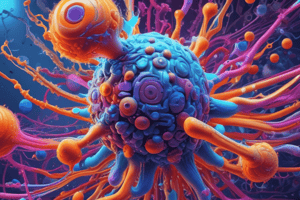Podcast
Questions and Answers
What is the primary role of intracellular cAMP in cell signaling?
What is the primary role of intracellular cAMP in cell signaling?
- To regulate homeostasis, such as salt and water levels (correct)
- To regulate calcium levels
- To inhibit protein synthesis
- To increase intracellular calcium levels
What effect does Cholera Toxin have on GTP and GDP signaling?
What effect does Cholera Toxin have on GTP and GDP signaling?
- It promotes GTP hydrolysis to GDP
- It inhibits GTP to prevent cAMP production (correct)
- It activates GDP to inhibit cAMP production
- It facilitates the conversion of GTP to cAMP
What are the two types of second messengers generated by the activation of Phospholipase C?
What are the two types of second messengers generated by the activation of Phospholipase C?
- DAG and IP3 (correct)
- cAMP and IP3
- PKC and DAG
- cAMP and DAG
Which of the following responses is associated with the activation of Phospholipase C through Vasopressin?
Which of the following responses is associated with the activation of Phospholipase C through Vasopressin?
What is the key factor determining how a target cell responds to an extracellular signal?
What is the key factor determining how a target cell responds to an extracellular signal?
What is an example of a signal that acts over long distances in the body?
What is an example of a signal that acts over long distances in the body?
What cellular mechanism does the neurotransmitter acetylcholine engage in cardiac tissue?
What cellular mechanism does the neurotransmitter acetylcholine engage in cardiac tissue?
Which of the following responses is NOT typically associated with the fight or flight response?
Which of the following responses is NOT typically associated with the fight or flight response?
What is the primary role of Diacylglycerol (DAG) once generated?
What is the primary role of Diacylglycerol (DAG) once generated?
Which type of drug mimics endogenous signals in GPCR signaling?
Which type of drug mimics endogenous signals in GPCR signaling?
How do cells typically respond to signals amidst the presence of multiple signals?
How do cells typically respond to signals amidst the presence of multiple signals?
During a fight or flight response, which of the following occurs in the liver?
During a fight or flight response, which of the following occurs in the liver?
What factor critically influences how a target cell interprets a signal?
What factor critically influences how a target cell interprets a signal?
Which of the following is a characteristic of short-distance signaling?
Which of the following is a characteristic of short-distance signaling?
In terms of signal molecules, which statement is true?
In terms of signal molecules, which statement is true?
What role does adrenaline play in cellular responses during the fight or flight response?
What role does adrenaline play in cellular responses during the fight or flight response?
What primarily determines how a cell will respond to a given signal?
What primarily determines how a cell will respond to a given signal?
Which type of receptor allows ions to flow across the plasma membrane?
Which type of receptor allows ions to flow across the plasma membrane?
What is a characteristic of G-protein coupled receptors (GPCRs)?
What is a characteristic of G-protein coupled receptors (GPCRs)?
Which of the following is NOT a feature of cell surface receptors?
Which of the following is NOT a feature of cell surface receptors?
How do responses to signals differ in cells?
How do responses to signals differ in cells?
What is the role of extracellular signals in cellular signaling?
What is the role of extracellular signals in cellular signaling?
Which of the following statements about receptors is accurate?
Which of the following statements about receptors is accurate?
Which type of receptor is expected to activate enzymes following ligand binding?
Which type of receptor is expected to activate enzymes following ligand binding?
What is the primary function of receptor antagonists?
What is the primary function of receptor antagonists?
What allows GPCRs to activate associated G proteins?
What allows GPCRs to activate associated G proteins?
Which type of signaling allows for communication across long distances in the body?
Which type of signaling allows for communication across long distances in the body?
What distinguishes extracellular receptors from intracellular receptors?
What distinguishes extracellular receptors from intracellular receptors?
How do signals vary in their reach and effectiveness?
How do signals vary in their reach and effectiveness?
Which statement about ligands and receptor binding is correct?
Which statement about ligands and receptor binding is correct?
What type of signaling molecules can be classified as intracellular?
What type of signaling molecules can be classified as intracellular?
What is a common characteristic of all signaling molecules?
What is a common characteristic of all signaling molecules?
What is the primary function of receptor tyrosine kinases (RTKs)?
What is the primary function of receptor tyrosine kinases (RTKs)?
How many human receptor tyrosine kinases are identified?
How many human receptor tyrosine kinases are identified?
What type of receptors can activate enzyme-coupled receptors?
What type of receptors can activate enzyme-coupled receptors?
What is the role of autotransphosphorylation in RTK activation?
What is the role of autotransphosphorylation in RTK activation?
What feature is common to all receptor tyrosine kinases?
What feature is common to all receptor tyrosine kinases?
Which statement about RTKs being molecular switches is true?
Which statement about RTKs being molecular switches is true?
What type of responses can cell signaling result in?
What type of responses can cell signaling result in?
What did Robert Lefkowitz and Brian Kobilka discover that earned them the Nobel Prize in Chemistry?
What did Robert Lefkowitz and Brian Kobilka discover that earned them the Nobel Prize in Chemistry?
What is the significance of the single membrane spanning alpha-helical domain in RTKs?
What is the significance of the single membrane spanning alpha-helical domain in RTKs?
Which Nobel Prize was awarded for the discovery related to signal transduction in the nervous system?
Which Nobel Prize was awarded for the discovery related to signal transduction in the nervous system?
Enzyme-coupled receptors are primarily activated by?
Enzyme-coupled receptors are primarily activated by?
What is one characteristic of molecular switches in cell signaling?
What is one characteristic of molecular switches in cell signaling?
Which of the following scientists contributed to the understanding of how cells sense oxygen, leading to a Nobel Prize in Medicine?
Which of the following scientists contributed to the understanding of how cells sense oxygen, leading to a Nobel Prize in Medicine?
Flashcards
Cell Response to Signals
Cell Response to Signals
Cells selectively respond to signals by activating specific receptors and intracellular molecules, leading to fast or slow responses, impacting gene expression or protein function.
Signal Molecules
Signal Molecules
Signal molecules vary in size, hydrophobicity, and stability, influencing how they travel and interact with target cells.
Ligand-Gated Ion Channels
Ligand-Gated Ion Channels
Cell-surface receptors that allow ions to flow across the membrane, changing the cell's electrical activity in response to a ligand.
Short-distance signaling
Short-distance signaling
Signup and view all the flashcards
G-protein Coupled Receptors (GPCRs)
G-protein Coupled Receptors (GPCRs)
Signup and view all the flashcards
Intracellular Receptors
Intracellular Receptors
Signup and view all the flashcards
Long-distance signaling
Long-distance signaling
Signup and view all the flashcards
Cell Surface Receptors
Cell Surface Receptors
Signup and view all the flashcards
Cellular responses (to signals)
Cellular responses (to signals)
Signup and view all the flashcards
Signal Transduction
Signal Transduction
Signup and view all the flashcards
Receptor Classification
Receptor Classification
Signup and view all the flashcards
Target cell interpretation
Target cell interpretation
Signup and view all the flashcards
Multiple signals
Multiple signals
Signup and view all the flashcards
Specific signal response
Specific signal response
Signup and view all the flashcards
Fight-or-flight response
Fight-or-flight response
Signup and view all the flashcards
Phosphodiesterase inhibitors
Phosphodiesterase inhibitors
Signup and view all the flashcards
Cholera toxin
Cholera toxin
Signup and view all the flashcards
GPCRs
GPCRs
Signup and view all the flashcards
Phospholipase C
Phospholipase C
Signup and view all the flashcards
Diacylglycerol (DAG)
Diacylglycerol (DAG)
Signup and view all the flashcards
Inositol trisphosphate (IP3)
Inositol trisphosphate (IP3)
Signup and view all the flashcards
Intracellular Ca2+ signaling
Intracellular Ca2+ signaling
Signup and view all the flashcards
Signal Interpretation
Signal Interpretation
Signup and view all the flashcards
Why is cell communication essential?
Why is cell communication essential?
Signup and view all the flashcards
What are G-protein–coupled receptors?
What are G-protein–coupled receptors?
Signup and view all the flashcards
What is signal transduction?
What is signal transduction?
Signup and view all the flashcards
What is the 'fight-or-flight' response?
What is the 'fight-or-flight' response?
Signup and view all the flashcards
Who won the Nobel Prize in Chemistry in 2012?
Who won the Nobel Prize in Chemistry in 2012?
Signup and view all the flashcards
Receptor antagonists
Receptor antagonists
Signup and view all the flashcards
Cell signaling
Cell signaling
Signup and view all the flashcards
Intracellular Signaling
Intracellular Signaling
Signup and view all the flashcards
Enzyme-linked receptors
Enzyme-linked receptors
Signup and view all the flashcards
Enzyme-Coupled Receptors
Enzyme-Coupled Receptors
Signup and view all the flashcards
Receptor Tyrosine Kinases (RTKs)
Receptor Tyrosine Kinases (RTKs)
Signup and view all the flashcards
RTK Structure
RTK Structure
Signup and view all the flashcards
RTK Activation
RTK Activation
Signup and view all the flashcards
RTK Role
RTK Role
Signup and view all the flashcards
Phosphorylation in RTK Signaling
Phosphorylation in RTK Signaling
Signup and view all the flashcards
JAK-STAT Signaling
JAK-STAT Signaling
Signup and view all the flashcards
Enzyme-Coupled Receptors vs. GPCRs
Enzyme-Coupled Receptors vs. GPCRs
Signup and view all the flashcards
Study Notes
Lecture Information
- Lecture materials cover basic principles of cell biology, focusing on cell communication and signalling.
- Lecture 1 focused on principles of cell communication and steroid receptor signalling.
- Lecture 2 focused on ion channel and G-coupled protein receptor signalling.
- Lecture 3 focused on enzyme-coupled receptors.
- Lecture 4 focused on cell signalling in disease, specifically diabetes.
Cell Communication and Signalling
- Cell signalling involves four key steps: receive, recognise, relay, and respond.
- Cell signalling is crucial for coordinating cell functions, responding to environmental changes, maintaining homeostasis, and cell development and survival.
- Different types of cell signalling exist: autocrine, paracrine, juxtacrine, endocrine, and neuronal.
- Autocrine signalling involves releasing molecules that act upon the cell that produced them.
- Paracrine signalling involves releasing molecules that act upon nearby cells.
- Juxtacrine signalling involves direct contact between adjacent cells.
- Endocrine signalling involves hormones traveling through the bloodstream to target cells.
- Neuronal signalling involves transmitting signals through electrical and chemical impulses.
Cell signalling in disease - Diabetes
- Glucose homeostasis is tightly regulated in health by multiple hormones, including insulin and glucagon.
- Diabetes is a disorder of glucose homeostasis.
- Type 1 diabetes usually results from autoimmune destruction of insulin-producing beta cells.
- Type 2 diabetes arises from a combination of insulin resistance and inadequate insulin secretion.
- Insulin, produced in the pancreas islets of Langerhans, lowers blood glucose while glucagon raises levels through glycogen breakdown in the liver.
Key Receptors
- Ligand-gated ion channels are transmembrane proteins that open or close in response to specific ligands causing ion flow into and out of the cell.
- G-protein coupled receptors (GPCRs) are a large family of membrane-bound proteins, involved in a vast array of cellular processes, and are an important target for drugs.
- Enzyme-coupled receptors, such as receptor tyrosine kinases (RTKs) or JAK-STAT are membrane glycoproteins whose binding to specific ligands results in the activation of cytoplasmic signaling cascades.
- Different cell types have diverse responses to the same signal due to different intracellular pathways being activated.
- Insulin receptor (IR), is an enzyme-coupled receptor that regulates glucose uptake and glycogen synthesis.
Treatment of Diabetes Mellitus
- Current treatment approaches include insulin replacement (type 1 diabetes) or lifestyle modifications and/or pharmacological agents (type 2 diabetes).
Stem Cell Therapies in Diabetes
- Stem-based approaches to diabetes involve generating insulin-producing beta cells from stem cells.
- Current stem cell therapies such as VX-880 and VX-264 are in clinical trials.
- The use of stem cells to generate stem cell-derived islets might overcome problems associated with traditional treatments and address complications.
Studying That Suits You
Use AI to generate personalized quizzes and flashcards to suit your learning preferences.




